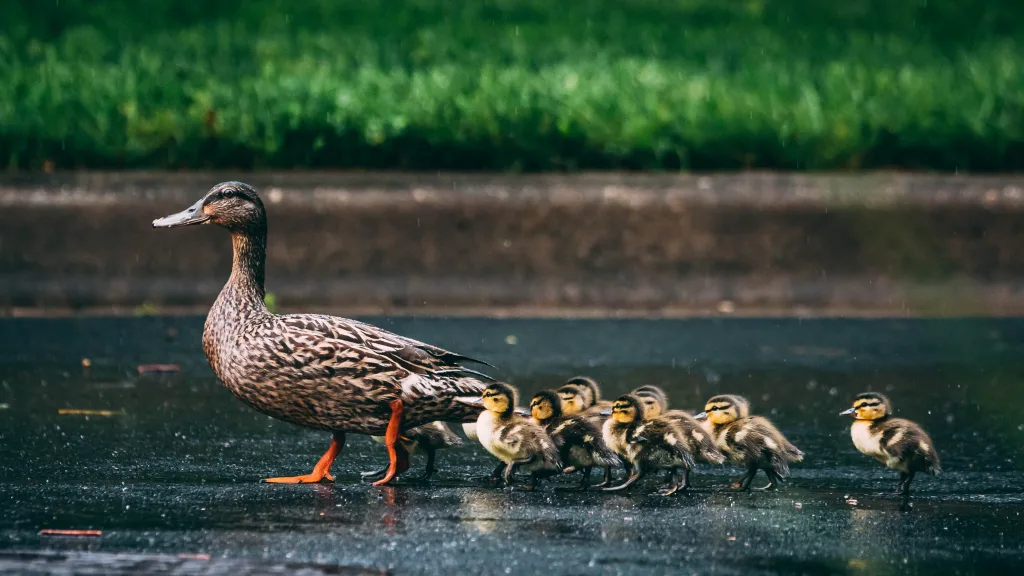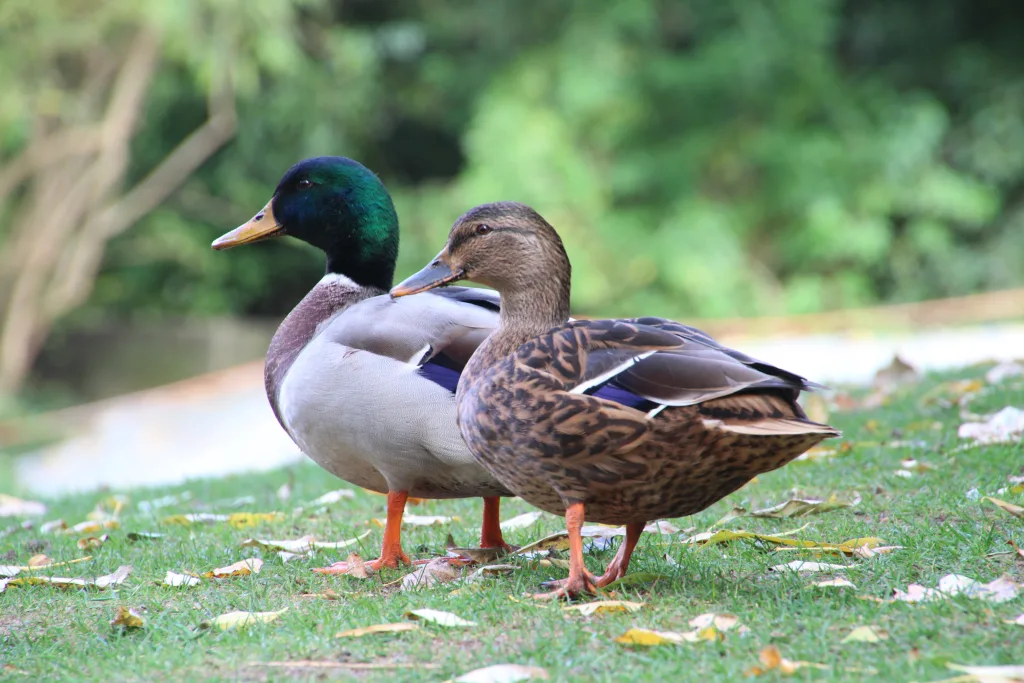Ducks are fascinating creatures, known for their ability to gracefully glide across water surfaces and take to the skies with ease. One of the most important features that enable them to do so is their feathers. Feathers not only provide protection from the elements but also play a crucial role in their ability to fly.
Feathers come in different types and serve various functions for ducks. The three main types of feathers found in waterfowl, including ducks, are contour feathers, flight feathers, and down feathers. Each of these feathers has its own unique purpose and contributes to the overall well-being of the bird.
Contour feathers are the visible outer layer of feathers that give ducks their characteristic appearance. These feathers are strong, flexible, and provide a streamlined shape to the bird’s body, enabling efficient movement through the air and water. They also act as a protective barrier, shielding the bird from rain, wind, and other harsh elements.
Flight feathers, as the name suggests, are specifically designed to facilitate flight. These feathers are found on the wings and tail of the duck and provide the necessary lift and thrust required for takeoff and sustained flight. Flight feathers are lightweight and have a specialized structure that allows air to pass through them, reducing air resistance and enabling efficient flight.
While contour and flight feathers are vital for a duck’s mobility and protection, down feathers play a crucial role in insulation. Down feathers are soft and fluffy, with a loose structure that creates air pockets. These air pockets trap heat and help to regulate the bird’s body temperature, keeping it warm even in cold water or harsh weather conditions. The insulating properties of down feathers are so effective that even when a duck dives underwater, the downy layer next to its skin remains dry.
Ducks utilize their down feathers not only for personal insulation but also for nest building. When it comes to protecting their eggs, ducks pluck down feathers from their breasts to create a soft and cozy lining for their nests. This down lining acts as a natural insulator, keeping the eggs warm and protected from frigid temperatures and strong winds.
Feathers are of utmost importance to ducks, serving multiple functions that are essential for their survival and well-being. From providing protection against the elements to enabling flight and facilitating insulation, feathers are a marvel of nature’s design. So next time you observe a duck gracefully gliding across the water or taking flight into the sky, remember to appreciate the incredible role that its feathers play in making these actions possible.
Why Do Ducks Have Down Feathers?
Ducks have down feathers for several reasons:
1. Insulation: The loose structure of down feathers helps to trap air, creating a layer of insulation around the bird’s body. This insulation is vital for ducks as it helps them regulate their body temperature in cold environments. The air pockets within the down feathers act as a barrier against heat loss, keeping the bird warm.
2. Buoyancy: Down feathers also play a crucial role in providing buoyancy to waterbirds like ducks. The air trapped within the feathers increases their overall volume, making the bird more buoyant in water. This buoyancy allows ducks to float effortlessly and helps them stay afloat while swimming or resting on water.
3. Lightweight: Down feathers are incredibly lightweight, which is advantageous for birds during flight. These feathers enable ducks to maintain a streamlined body shape, reducing drag and conserving energy while in the air. The lightness of down feathers also allows ducks to move swiftly through the water, making swimming and diving more efficient.
4. Water repellency: Although down feathers are not completely waterproof, they do have some water-repellent properties. The fluffy structure of the feathers helps to repel water and prevent it from reaching the bird’s skin. This feature is particularly useful for ducks, as it helps to keep their bodies dry while swimming or foraging in wet environments.
The presence of down feathers in ducks serves multiple purposes, including insulation, buoyancy, lightweight flight, and water repellency. These feathers contribute to the overall survival and adaptability of ducks in various environments, both on land and in water.

What Do Duck Feathers Do?
Duck feathers serve several important functions:
1. Protection from the elements: Feathers act as a natural insulation, keeping ducks warm in cold weather. The contour feathers, which form the outer layer of feathers, provide a waterproof barrier that prevents water from reaching the bird’s skin. This waterproofing ability is due to the presence of special oil-producing glands near the base of the tail that ducks use to preen and distribute oil over their feathers.
2. Facilitate flight: Flight feathers, also known as remiges, are large and strong feathers found on the wings and tail of ducks. These feathers are essential for flight, providing lift and stability. The arrangement of flight feathers on the wings creates an aerodynamic shape, allowing ducks to soar through the air with ease.
3. Enhance buoyancy: Ducks spend a significant amount of time in water, and their feathers play a crucial role in keeping them buoyant. The down feathers, which are soft and fluffy, trap air close to the bird’s body, providing buoyancy and helping the duck float effortlessly on the water’s surface.
4. Camouflage: Many duck species have feathers that are specifically designed to blend in with their natural surroundings. These camouflage feathers help ducks hide from predators and make it easier for them to sneak up on prey while hunting.
5. Courtship and mating: Feathers also play a role in courtship displays and attracting mates. Male ducks often have brightly colored feathers or unique patterns that they display to impress females during the breeding season. These feathers serve as a visual signal of the male’s fitness and genetic quality.
Duck feathers provide insulation, waterproofing, flight capabilities, buoyancy, camouflage, and contribute to courtship displays. They are a vital adaptation that enables ducks to survive and thrive in a variety of environments.
Does A Duck Have Fur Or Feathers?
A duck has feathers, not fur. Feathers are the outer covering of a bird’s body, while fur is the hair covering on mammals. Feathers serve several important functions for ducks, including providing insulation, enabling flight, and aiding in waterproofing.
Here are some key points about a duck’s feathers:
– Feathers are made of a protein called keratin, which gives them strength and flexibility.
– Ducks have two main types of feathers: contour feathers and down feathers.
– Contour feathers are the large, stiff feathers that give a duck its shape and allow it to fly. These feathers have a central shaft with interlocking barbs that create a smooth, streamlined surface.
– Down feathers are the soft, fluffy feathers found underneath the contour feathers. They provide insulation by trapping air close to the duck’s body, helping to keep it warm in cold water or during chilly weather.
– The feathers of a duck are tightly packed together, forming a dense layer that helps to repel water. This waterproofing is essential for ducks, as it allows them to stay dry and buoyant while swimming or diving.
– A duck’s feathers have specialized structures that help with waterproofing. These include tiny, interlocking barbs and barbules, as well as an oily substance called preen oil that ducks spread over their feathers to maintain their waterproofing properties.
– When a duck dives underwater, its feathers do get wet, but the downy underlayer stays dry due to the waterproofing properties of the outer feathers. This helps to insulate the duck and prevent its body temperature from dropping.
Ducks have feathers, not fur. Feathers are essential for ducks, providing insulation, enabling flight, and ensuring waterproofing. The specialized structure of a duck’s feathers helps to keep the downy underlayer dry even when the duck dives underwater.
Do Feathers Keep Ducks Warm?
Feathers play a crucial role in keeping ducks warm. Ducks have a unique and highly efficient insulation system provided by their feathers. The feathers act as a natural barrier against cold temperatures and help to regulate the duck’s body temperature.
Ducks have two types of feathers: contour feathers and down feathers. Contour feathers are the outermost layer and are responsible for providing the waterproofing capability. They have a structure that prevents water from penetrating through to the skin, keeping the duck’s body dry even when swimming in cold water.
Underneath the contour feathers, ducks have a layer of down feathers. These down feathers are exceptionally soft and fluffy and are responsible for trapping air close to the duck’s body. Air is a poor conductor of heat, so the trapped air acts as an insulating layer, preventing heat loss. This insulation mechanism is similar to the way a down vest or jacket keeps us warm.
Additionally, ducks have a layer of fat beneath their skin, which provides extra insulation and helps to retain body heat. This layer of fat acts as an energy reserve and also helps to keep the ducks buoyant in water.
In extreme cold conditions, ducks may further protect themselves by fluffing up their feathers to increase the insulation effect. This traps even more air close to their bodies, providing an additional layer of warmth.
It is worth mentioning that ducks also use their down feathers to protect their eggs. Adult ducks pluck down feathers from their breasts to create a cushioned and insulated nest for their eggs. This helps to keep the eggs at a stable temperature and protects them from the frigid temperatures and winds.
Feathers are essential for keeping ducks warm. They provide waterproofing, insulation, and protection for both the ducks’ bodies and their eggs. This remarkable adaptation allows ducks to thrive in various environments, including cold and wet conditions.

Conclusion
Ducks have evolved remarkable adaptations to protect themselves from the elements and enable their survival in various environments. Their feathers play a crucial role in keeping them warm, dry, and buoyant. The specialized structure of their down feathers helps to trap air and provide insulation, which is essential for staying warm in cold weather and water. Additionally, the waterproof outer feathers ensure that even when ducks dive underwater, their downy underlayer remains completely dry. This combination of waterproof and insulating feathers allows ducks to thrive in both aquatic and terrestrial habitats. Furthermore, ducks also utilize their down feathers to create comfortable nests, providing insulation and protection for their eggs. the remarkable properties of duck feathers highlight the incredible adaptations that birds have developed to adapt to their surroundings and ensure their survival.
